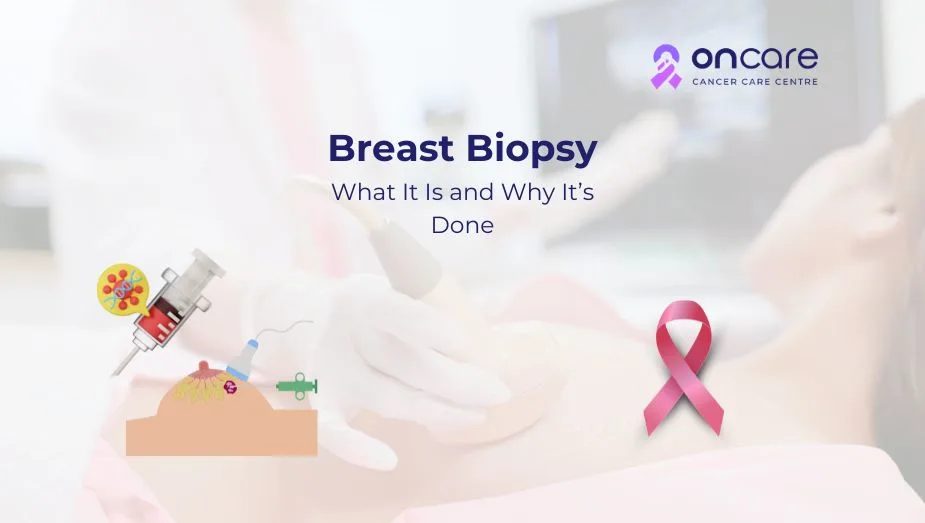Table of Contents
Breast Biopsy: What It Is and Why It’s Done

Breast biopsies are one of the reliable and safe diagnostic tools used to detect breast cancer or breast abnormalities in women. However, hearing about breast biopsy tests can often feel intimidating and triggering to handle. While understanding what it is and why it’s performed can reduce anxiety and uncertainties about your breast health.
In this article, we’ll discover more about the types of biopsy, the need for a biopsy procedure, and what to expect before and after the procedure.
What is a breast biopsy?
Breast biopsy is a medical procedure performed mostly on women. A healthcare practitioner removes a sample of breast tissue to examine under the microscope. This procedure is generally performed when there is a suspicion of abnormalities or signs of breast cancer.
Undergoing a biopsy never means that you have cancer. In reality, 80% of women who have performed breast biopsies don’t have breast cancer.
When do you need a breast biopsy and why is it done?
A cancer specialist usually suggests this biopsy after imaging test results that might show the signs of cancer.
For instance, a doctor might suggest getting a biopsy if:
- A lump or thickening inside the breast
- Mammogram results shows an abnormal areas in the breast
- Breast ultrasound shows an area of breast that could be a cancer
- Unusual changes in the nipple or areola
- Crusting, dimpling skin, or unusual discharge
Types of breast biopsies
There are different types of breast biopsies that involve different procedures. Your doctor might recommend different types of biopsies for your condition.
Here are some different types of biopsies, including
- Fine- Needle Aspiration (FNA) biopsy: A radiologist often performs this medical procedure on a suspected patient. They usually use a syringe with a thin needle to remove fluid and tissue from the breast.
- Core Needle Breast Biopsy: The radiologist usually uses a large needle when compared to the FNA biopsy. The large needle means that your radiologist can get more breast tissue than the number of tissue that an FNA removes.
- Excisional Breast Biopsy: This type of surgery removes all cancerous tissue in the area when tests find breast abnormalities. The surgeon might remove some of the normal tissue that surrounds any abnormal area.
- Incisional Breast Biopsy: The surgeon only removes a part of the abnormal tissue in the targeted area.
What’s to expect during the procedure?
Breast biopsies are different depending on the type of biopsy recommended by a healthcare practitioner. The doctor might give you a local anesthesia before the biopsy. The doctor might numb the area and use imaging to guide the needle and remove the sample.
After the procedure, the doctor might apply the pressure and put the bandage on the site. This helps with preventing the risk of bleeding. Some people might experience some discomfort, develop bruising, or swelling. However, serious complications are often rare.
What happens after the biopsy?
The tissue sample is often sent to the pathology lab for further analysis. The results of these tests often come after a few days.
These results might show:
- Benign conditions such as fibroadenomas or cysts
- Atypical hyperplasia, which may potentially raise a risk of cancer
- Invasive or non-invasive breast cancer
How long does a breast biopsy take?
The breast biopsy procedure time vary depending on the type of biopsy:
- Fine needle biopsy might take 10 to 15 minutes
- Core needle breast biopsies might take 20 to 60 minutes, depending on the imaging process that your radiologists use.
- Excisional breast biopsies (lumpectomies) might take up to 60 minutes.
- Incisional breast biopsies might take 60 minutes.
What are the risks and complications?
There are some common risks and side effects, including:
- Bruising
- Bleeding
- Swelling
- Pain or soreness
- Surgical wound infection
Consult your doctor if you experience any of the following symptoms or surgical wound infection. For example, a fever that’s more than 101 degrees Fahrenheit (38.4 degrees Celsius).
Why are breast biopsies important?
Biopsy procedures are essential for diagnosing breast cancer and other abnormalities in the breasts, which allows the pathologists to examine breast tissue samples under the microscope. Performing these tests helps to determine anything serious and harmful, such as cancerous, benign, or precancerous, and guides necessary treatment options.
A breast biopsy test always means you have cancer, but it’s a crucial step in getting clarity about your health conditions. If cancer is detected early, the survival rate is significantly higher, and treatment options are more effective in people and less aggressive.
Consult Today
Breast biopsies are safe and precise in nature. Try not to panic when your doctors recommend getting one. It’s important to stay proactive towards your health. Whether it confirms suspicion of cancer or anything harmless, the information can be life-changing and even life-saving.
At Oncare, we offer quality cancer treatments, including cancer surgeries, at affordable price ranges with an experienced cancer specialist consultation.
If you or any loved ones of yours are diagnosed with cancer, then visit Oncare Cancer Center and book an appointment with our expert cancer specialist today. Get an estimated cost of your cancer treatments.
Frequently Asked Questions
Breast biopsies are not painful. You might experience a pinch from the needle or IV insertion when you receive anesthesia. Some people experience pressure if you have fine-needle aspiration or core-needle biopsy.
Consult a doctor, if you experience some symptoms like this, including:
- Fever
- The skin around the biopsy site appear red or darker than the skin
- The area is painful to touch
- You develop significant bruising that’s spreading
Here are some of the potential complications, including:
- Bleeding that leads to a breast hematoma
- Infection
- Collapsed lung
- Hemathorax
- Hemapneumothorax
There are some common risks and side effects of biopsy, including
- Bruising
- Bleeding
- Swelling
- Pain
- Soreness
- Surgical wound infection

